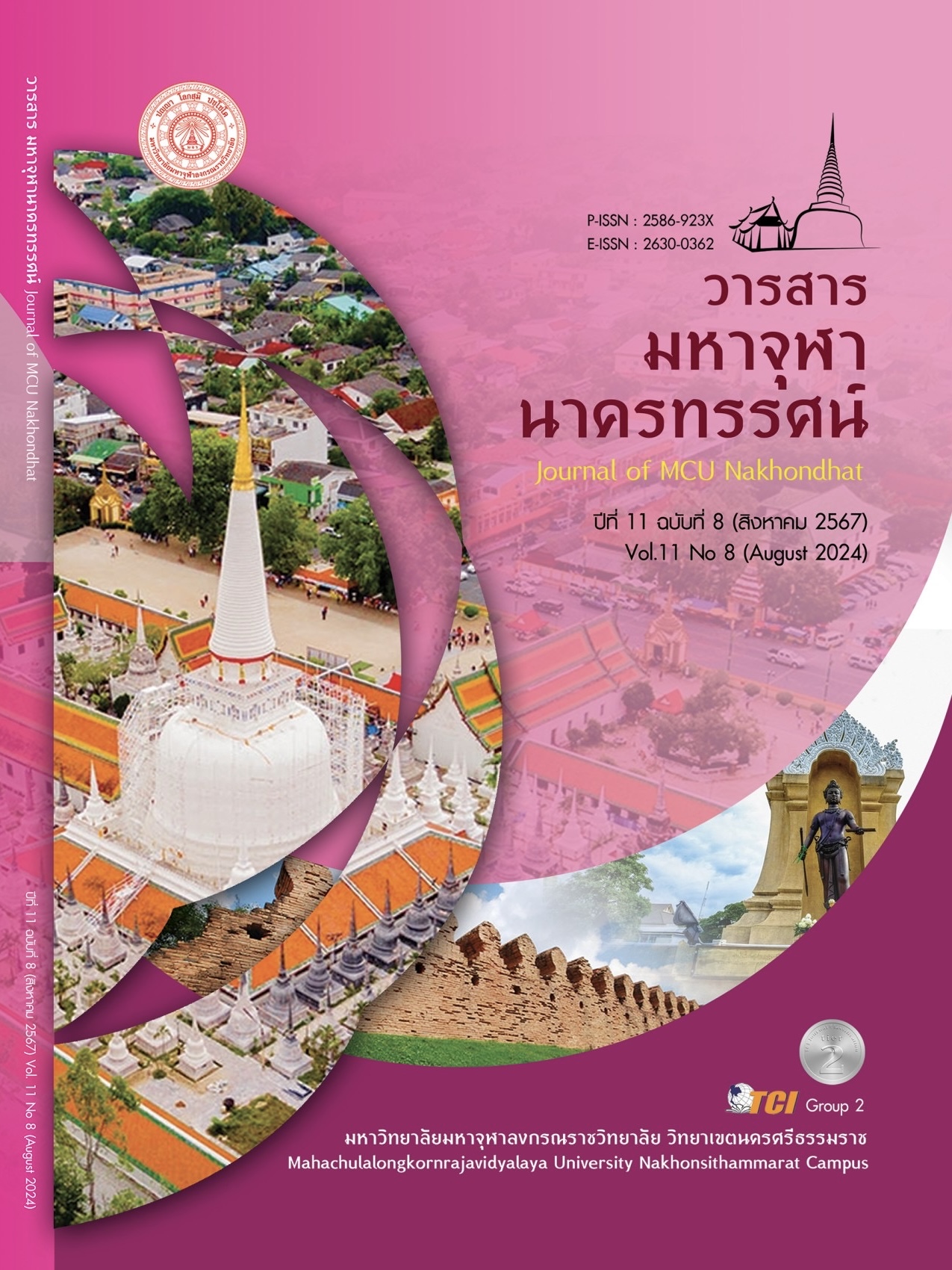การบัญญัติเรียก : พระสมถยานิกกับพระวิปัสสนายานิก
Main Article Content
บทคัดย่อ
บทความนี้ เป็นการศึกษาภาวะบุคคลที่มีพัฒนาการเข้าเกณฑ์การถูกบัญญัติเรียกว่า “พระสมถยานิก กับพระวิปัสสนายานิก” ซึ่งมีความเชื่อมโยงสัมพันธ์กับพระปัญญาวิมุตและพระอุภโตภาควิมุต ที่ยึดตามหลักการปฏิบัติสมถะวิปัสสนา เริ่มมีวิวัฒนาการมาตั้งแต่สมัยพุทธกาล ผ่านระบบไตรสิกขาที่พระพุทธองค์ทรงวางรากฐานไว้สำหรับเป็นหนทางไปสู่ความเป็นพระอรหันต์ในพระพุทธศาสนา และเพื่อให้มีความสอดคล้องกับสังคมชาวชมพูทวีปในสมัยนั้น ต่อมาในคัมภีร์ชั้นอรรถกถา และอรรถกถาฎีกา นิยมเรียกตามลักษณะการปฏิบัติสมถะวิปัสสนาโดยตรงมากขึ้น โดยใช้คำว่า “สมถยานิกกับวิปัสสนายานิก” เพื่อบรรยายความเชื่อมโยงไปถึงผู้กำลังดำเนินไปสู่ความเป็นพระอริยบุคคล 7 ทำให้สามารถขยายเนื้อความไปสู่ความเป็นพระสมถยานิกกับพระวิปัสสนายานิกด้วยเหตุผล 3 ประการ คือ 1) คำว่า “สมถยานิกกับวิปัสสนายานิก” ใช้ในฐานะเป็นศัพท์ระบุถึงรูปแบบการปฏิบัติวิปัสสนาทั้ง 4 แบบในพระพุทธศาสนาเถรวาท 2) คำว่า “สมถยานิกบุคคลกับวิปัสสนายานิกบุคคล” ใช้ในฐานะเป็นศัพท์คุณนาม โดยสภาวะมีความหมายเหมือนกับคำว่า “โยคี” หรือ “ภิกษุ” ผู้กำลังฝึกตน มีความเพียรฝึกฝนวิปัสสนา 3) คำว่า “พระสมถยานิกกับพระวิปัสสนายานิก” ใช้ในฐานะที่เป็นศัพท์ระบุสถานะพระอรหันต์ผู้บรรลุธรรมขั้นสูงสุดแล้ว หรือกลุ่มคำที่เป็นไวพจน์ในการใช้เรียกพระอรหันต์ทั้งหมดซึ่งจำแนกให้เห็นแนวทางการปฏิบัติสมถะวิปัสสนาที่พระอรหันต์ได้ใช้ฝึกฝน ก่อนการบรรลุอรหัตตผล และการบัญญัติเรียกคำจำกัดความในเชิงระบุถึงภาวะความเป็นพระอรหันต์มาปรากฏเด่นชัดในหนังสือพุทธธรรม และตำราวิชาการอื่น ๆ
Article Details

อนุญาตภายใต้เงื่อนไข Creative Commons Attribution-NonCommercial-NoDerivatives 4.0 International License.
เอกสารอ้างอิง
จุฑาภัค หริรักษ์ธํารง. (2560). รูปแบบการบรรลุธรรมในพระพุทธศาสนาเถรวาท. ใน ดุษฎีนิพนธ์พุทธศาสตร์ สาขาวิชาพระพุทธศาสนา. มหาวิทยาลัยมหาจุฬาลงกรณราชวิทยาลัย.
ธีรโชติ เกิดแก้ว. (2564). พระปัญจวัคคีย์ในขณะที่ฟังปฐมเทศนาบวชเป็นพระภิกษุแล้วหรือยัง. วารสารบัณฑิตศึกษาปริทรรศน์, 17(2), 19-41.
พระกัมมัฏฐานาจริยาะ อู กุณฑลาภิวงศ์. (2541). ทำอินทรีย์ให้แก่กล้า. กรุงเทพมหานคร: โรงพิมพ์ บริษัท สหธรรมิก จำกัด.
พระพรหมคุณาภรณ์ (ป.อ.ปยุตฺโต). (2557). พุทธธรรม ฉบับปรับขยาย. กรุงเทพมหานคร: โรงพิมพ์ มหาจุฬาลงกรณราชวิทยาลัย.
พระภัททันตะ อาสภมหาเถระอัคกัมมัฏฐานาจริยะ. (2539). วิปัสสนาทีปนีฎีกา. (พิมพ์ครั้งที่ 8). กรุงเทพมหานคร: โรงพิมพ์มหาจุฬาลงกรณราชวิทยาลัย.
พระภาวนาพิศาลเมธี วิ (ประเสริฐ มันตเสวี). (2567). ลำดับการปฏิบัติสติปัฏฐาน 4 แนวธัมมานุสารี. กรุงเทพมหานคร: โรงพิมพ์ ห้างหุ้นส่วนจำกัด ประยูรสาส์นไทย การพิมพ์.
พระมหาพงศ์ศักดิ์ ฐานิโย. (2558). พระอรหันต์ปัญญาวิมุต ต้องอาศัยฌานสมาบัติในการบรรลุธรรมหรือไม่. วารสารธรรมธารา, 1(1), 159-184.
พระมหาศุภจิตร์ ธมฺมาโภ (หอประสงค์ผล). (2561). ศึกษาการบรรลุธรรมแบบสุกขวิปัสสกะในคัมภีร์พุทธศาสนาเถรวาท. ใน สารนิพนธ์พุทธศาสตรมหาบัณฑิต สาขาวิชาพระพุทธศาสนา. มหาวิทยาลัยมหามกุฏราชวิทยาลัย.
พระสมศักดิ์ สุทฺธิจาโค (ธิดา). (2557). ศึกษาการบรรลุธรรมในพระพุทธศาสนาเถรวาท เฉพาะกรณีของพระพาหิยทารุจีริยเถระ. ใน วิทยานิพนธ์พุทธศาสตรมหาบัณฑิต สาขาวิชาพระพุทธศาสนา. มหาวิทยาลัยมหาจุฬาลงกรณราชวิทยาลัย.
มหาจุฬาลงกรณราชวิทยาลัย. (2535). พระไตรปิฎกภาษาบาลี ฉบับมหาจุฬาเตปิฏก 2500. กรุงเทพมหานคร: โรงพิมพ์มหาจุฬาลงกรณราชวิทยาลัย.
มหาจุฬาลงกรณราชวิทยาลัย. (2539). พระไตรปิฎกภาษาไทย ฉบับมหาจุฬาลงกรณราชวิทยาลัย. กรุงเทพมหานคร: โรงพิมพ์มหาจุฬาลงกรณราชวิทยาลัย.
มหามกุฏราชวิทยาลัย. (2556). พระไตรปิฎกภาษาบาลี อรรถกถา ฉบับมหามกุฏราชวิทยาลัย. กรุงเทพมหานคร: รงพิมพ์มหามกุฏราชราชวิทยาลัย.
สมเด็จพระพุฒาจารย์ (อาจ อาสภมหาเถร). (2560). วิสุทธิมรรค. (พิมพ์ครั้งที่ 12). กรุงเทพมหานคร: โรงพิมพ์ บริษัท ธนาเพรส จำกัด.
สมเด็จพระพุทธโฆษาจารย์ (ป.อ.ปยุตฺโต). (2564). พจนานุกรมพุทธศาสตร์ ฉบับประมวลธรรม. (พิมพ์ครั้งที่ 43). กรุงเทพมหานคร: โรงพิมพ์ บริษัท สหธรรมิก จำกัด.


